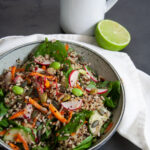Soy
Here’s a convenient overview of everything you need to know about soy:
Emissions
Did you know that soy has a 25 times smaller carbon footprint than beef? A study by the American Association for the Advancement of Science (AAAS) calculated on the basis of 1,530 studies from 119 countries that beef produces an average emmision of 50 kg of CO2 per 100 grams of protein, while soy only emits 2 kg.
Land use
And the land use? They calculated that on average only 2.2 m² of land is needed for soy per 100 grams of protein. That’s only a fraction of the 185 m² or 164 m² you need for the equivalent in respectively lamb and mutton or beef.
Water consumption
And the water footprint? A study by the IHE Institute for Water Education calculated that 100 grams of soybeans require an average of 215 liters of water, while according to another study by the same institute, 100 grams of beef consumes an average of 1,540 liters of water worldwide. Converted to numbers per 100 grams of protein, you get this result thanks to the high protein content of soybeans (36% of the dry weight):
Deforestation
But what about deforestation? Argentina and Brazil are both in the top 3 countries worldwide in terms of soy production. To keep up with the growing demand, a lot of valuable nature reserves are being deforested to make way for agricultural land. So actually, this is not a weir question to ask. But in fact, we use the majority of our soy harvest as animal feed. Worldwide this would account for about 75 percent.
According to the WWF, Belgium also imports an annual 2 million hectares of soy, mainly from Argentina and Brazil. Three quarters of this is intended as animal feed. We only use 3% of our imported soy for human consumption. And that soy comes mainly from Canada and Europe. Since 2017, soy for human consumption has also been successfully grown in Belgium. So if you want to fight deforestation, it’s better to eat soy yourself than indirectly via animal products.
Health
Is soy actually healthy? Of all the plant-based proteins, soy protein is one of the most complete: it contains all essential amino acids in sufficient quantity. That is why soy is also one of the most commonly used products for meat substitutes: from tofu and tempeh to burgers and fillet pieces. Since 2017, the Flemish Institute of Healthy Living has also adjusted the food triangle. Since then, they officially recommend to eat less red and processed meat and to consider alternative protein sources such as legumes, including soy. So yes, soy definitely belongs in a healthy diet. Unless of course you are allergic to it!
Do you have any other questions about soy? Feel free to ask them in the comments below!





